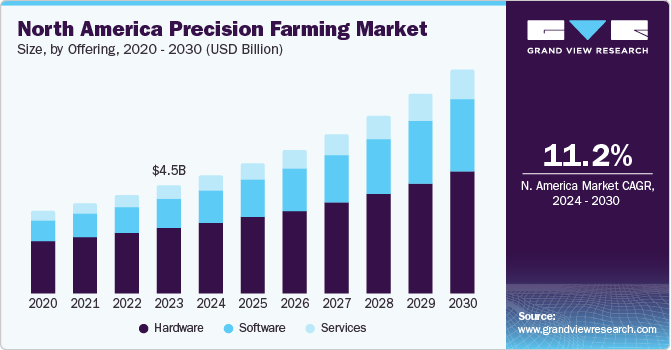Precision Farming Industry Overview
The global precision farming market size was valued at USD 6.96 billion in 2021 and is expected to expand at a compound annual growth rate (CAGR) of 12.8% from 2022 to 2030.
The growth of precision agriculture is attributed to the burgeoning proliferation of the Internet of Things (IoT) along with the use of advanced analytics by farmers. Advanced analytics is a part of data science that uses numerous tools and methods to forecast data and ensure that the crop and soil receive adequate nurturing. This helps farmers to plan their actions accordingly.
Gather more insights about the market drivers, restrains and growth of the Global Precision Farming Market
For a deep understanding of different farming aspects such as irrigation and plowing, numerous technologies such as IoT, GPS, and remote sensing application control are used. IoT helps farmers address various challenges involved in the proper monitoring of crops. It provides real-time data about environment temperature and water content in the soil through sensors placed on the farm, which assists farmers in making improved decisions about harvesting times, crop market rate, and soil management. This is one of the key factors contributing to the growth of the market for precision farming.
Other factors that facilitate the adoption of sustainable farming technologies include better education and training for farmers, easily accessible information, availability of financial resources, and high demand for organic food. The depletion of natural resources and deterioration of the environment are some of the factors responsible for limiting crop production. Growing environmental concerns are encouraging farmers to shift their focus toward sustainable agriculture practices, such as the preservation of natural resources. This has driven the need for improving crop nutrition and protection, in turn bolstering the market growth.
Technological innovations, such as vertical farming with smart designs to maximize yields and reduce waste, have unfolded numerous growth opportunities. Moreover, increasing investments in technologies such as driverless tractors, guidance systems, and GPS sensing systems are also expected to contribute to the growth of the precision agriculture market size during the period of study. For instance, numerous sensors such as soil sensors, climate sensors, and water sensors are placed around the fields to help farmers monitor their crops and gain real-time information. Additionally, these sensors also help farmers obtain a high yield with less crop wastage. These sensors are also highly adopted in different applications such as agriculture, pharmaceutical and healthcare, automotive, and sports.

The outbreak of COVID-19 has adversely affected the global market for precision farming with several manufacturing units across China, India, European countries, Japan, and the U.S. temporarily shutting down. This has consequently led to a significant slowdown in the production of precision farming equipment. Lockdowns imposed by the governments in the wake of the coronavirus pandemic affected manufacturing and pegged back the consumer demand for such high capital equipment.
However, the use of farm management software tools and remote sensing could lead to higher adoption post-COVID-19 period. Companies have already begun focusing more on wireless platforms to enable real-time decision-making for crop health monitoring, yield monitoring, irrigation scheduling, field mapping, and harvesting management.
The North America precision farming market emerged as a profitable revenue belt in 2021, owing to the higher adoption of the technologies and devices such as the guidance system, and Variable Rate Technology (VRT) for growing crops. On the other side, smart solutions involve high investments, which act as a drawback for farmers, especially in developing countries such as China, India, and Brazil. The investment in the precision agriculture market is high, however, in the later run, it offers a notable return on investment as it reduces the overall production cost and increases efficiency.
Browse through Grand View Research's Next Generation Technologies Industry Related Reports
- Vertical Farming Market - The global vertical farming market size was valued at USD 4.34 billion in 2021 and is expected to expand at a compound annual growth rate (CAGR) of 25.5% from 2022 to 2030. The market growth is attributed to the growing adoption of environment-friendly production of fruits and vegetables.
- Precision Viticulture Market - The global precision viticulture market size was valued at USD 1.27 billion in 2019 and is expected to grow at a compound annual growth rate (CAGR) of 9.2% from 2020 to 2027. Precision viticulture aids in increasing the output of the vineyard by providing enhanced monitoring and control of the area under cultivation.
Market Share Insights
December 2018: AgJunction Inc. entered into a partnership with Mahindra and Mahindra Ltd. With this agreement, both the companies agreed to prepare a statement of work for the future development of products for the farmers.
September 2017: China and Israel signed a trade agreement worth USD 300 million to facilitate the export of environment-friendly Israeli technology to China.
Key Companies profiled:
Some prominent players in the global Precision Farming market include
- Ag Leader Technology
- AgJunction, Inc.
- CropMetrics LLC
- Trimble, Inc.
- AGCO Corporation
- Raven Industries Inc.
- Deere and Company
- Topcon Corporation
Order a free sample PDF of the Precision Farming Market Intelligence Study, published by Grand View Research.


No comments:
Post a Comment